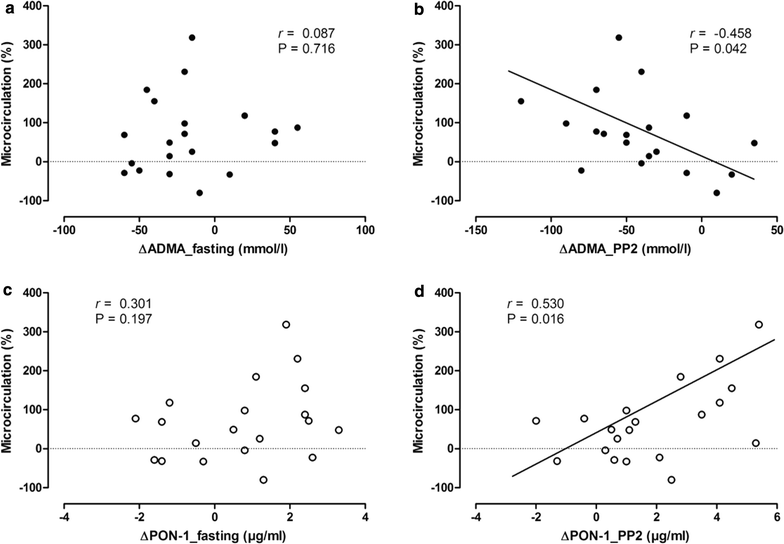Effect of rosuvastatin on fasting and postprandial endothelial biomarker levels and microvascular reactivity in patients with type 2 diabetes and dyslipidemia: a preliminary report
- PMID: 29121934
- PMCID: PMC5679486
- DOI: 10.1186/s12933-017-0629-0
Effect of rosuvastatin on fasting and postprandial endothelial biomarker levels and microvascular reactivity in patients with type 2 diabetes and dyslipidemia: a preliminary report
Retraction in
-
Retraction Note: Effect of rosuvastatin on fasting and postprandial endothelial biomarker levels and microvascular reactivity in patients with type 2 diabetes and dyslipidemia: a preliminary report.Cardiovasc Diabetol. 2019 Mar 16;18(1):32. doi: 10.1186/s12933-019-0841-1. Cardiovasc Diabetol. 2019. PMID: 30876421 Free PMC article.
Abstract
Background: The cardiovascular benefits of statins have been proven, but their effect on circulation in small vessels has not been examined fully. We investigated the effect of 20 mg rosuvastatin on biomarkers, including paraoxonase-1 (PON-1) and asymmetric dimethylarginine (ADMA), and on microvascular reactivity.
Method: We enrolled 20 dyslipidemic patients with type 2 diabetes and 20 age- and body mass index (BMI)-matched healthy controls. Rosuvastatin (20 mg/day) was given to the patient group for 12 weeks. Biochemical parameters, including PON-1 and ADMA, were compared between the patient and control groups, and before and after rosuvastatin treatment in the patient group. Fasting and 2 h postprandial levels of PON-1 and ADMA after mixed-meal challenge were also compared. Microvascular reactivity in a peripheral artery was examined using laser Doppler flowmetry.
Results: The respective mean ± standard deviation of age and BMI were 50.1 ± 3.8 year and 25.8 ± 3.7 kg/m2 in the patients and 50.2 ± 3.2 year and 25.4 ± 3.4 kg/m2 in the controls. The patient group had worse profiles of cardiometabolic biomarkers, including PON-1 and ADMA, than the controls. In the patients treated with 20 mg rosuvastatin, low-density lipoprotein (LDL)-cholesterol decreased from 147.2 ± 26.5 to 68.3 ± 24.5 mg/dL and high-density lipoprotein (HDL)-cholesterol increased from 42.4 ± 5.2 to 44.7 ± 6.2 mg/dL (both P < 0.05). Both fasting and 2 h postprandial levels of PON-1 increased and those of ADMA decreased after treatment with rosuvastatin for 12 weeks. The changes in postprandial levels of both biomarkers were greater than those after fasting. Microcirculation assessed as reactive hyperemia in the patients after an ischemic challenge increased significantly from 335.3 ± 123.4 to 402.7 ± 133.4% after rosuvastatin treatment. The postprandial changes in the biomarkers were significantly associated with improvement of microvascular reactivity.
Conclusions: Rosuvastatin treatment for 12 weeks improved microvascular reactivity with concomitant beneficial changes in the postprandial levels of PON-1 and ADMA. These results suggest that rosuvastatin improves the postprandial cardiometabolic milieu in type 2 diabetes. Trial registration ClinicalTrials.gov: NCT02185963 (July 7, 2014).
Keywords: Asymmetric dimethylarginine; Endothelial function; Microvascular reactivity; Paraoxonase 1; Rosuvastatin; Type 2 diabetes.
Figures


References
-
- Cholesterol Treatment Trialists C. Kearney PM, Blackwell L, Collins R, Keech A, Simes J, Peto R, Armitage J, Baigent C. Efficacy of cholesterol-lowering therapy in 18,686 people with diabetes in 14 randomised trials of statins: a meta-analysis. Lancet. 2008;371(9607):117–125. doi: 10.1016/S0140-6736(08)60104-X. - DOI - PubMed
-
- Colhoun HM, Betteridge DJ, Durrington PN, Hitman GA, Neil HA, Livingstone SJ, Thomason MJ, Mackness MI, Charlton-Menys V, Fuller JH, et al. Primary prevention of cardiovascular disease with atorvastatin in type 2 diabetes in the Collaborative Atorvastatin Diabetes Study (CARDS): multicentre randomised placebo-controlled trial. Lancet. 2004;364(9435):685–696. doi: 10.1016/S0140-6736(04)16895-5. - DOI - PubMed
-
- Hsia J, MacFadyen JG, Monyak J, Ridker PM. Cardiovascular event reduction and adverse events among subjects attaining low-density lipoprotein cholesterol < 50 mg/dl with rosuvastatin. The JUPITER trial (Justification for the Use of Statins in Prevention: an Intervention Trial Evaluating Rosuvastatin) J Am Coll Cardiol. 2011;57(16):1666–1675. doi: 10.1016/j.jacc.2010.09.082. - DOI - PubMed
-
- Umemoto T, Yasu T, Arao K, Ikeda N, Horie Y, Sugimura H, Kawakami M, Fujita H, Momomura SI. Pravastatin improves postprandial endothelial dysfunction and hemorheological deterioration in patients with effort angina pectoris. Heart Vessels. 2017 - PubMed
-
- Xu X, Liu Y, Li K, Wang P, Xu L, Yang Z, Yang X. Intensive atorvastatin improves endothelial function and decreases ADP-induced platelet aggregation in patients with STEMI undergoing primary PCI: a single-center randomized controlled trial. Int J Cardiol. 2016;222:467–472. doi: 10.1016/j.ijcard.2016.07.223. - DOI - PubMed
Publication types
MeSH terms
Substances
Associated data
Grants and funding
LinkOut - more resources
Full Text Sources
Other Literature Sources
Medical
Miscellaneous

